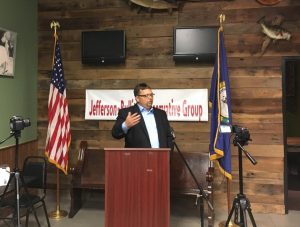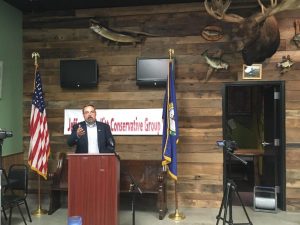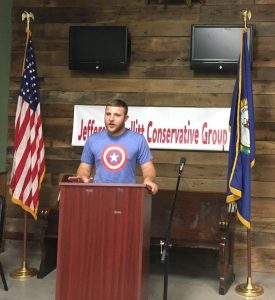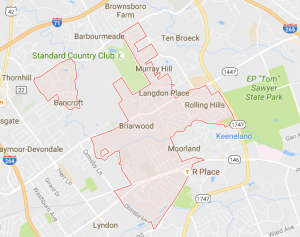Louisville Metro Government will begin this week installing locally created, low-cost wireless smoke detectors in vacant and abandoned properties, in an innovative way to reduce fire risk.
The city’s Innovation Delivery Team is guiding this one-of-a-kind project, with support from Louisville Fire, the Vacant and Public Property Administration, and Codes & Regulations.
 The smoke detectors, which use a cellular 3G wireless connection to alert authorities when a fire erupts in a vacant and abandoned property, were created through a partnership with local civic hackers. The idea is to avoid devastating fires and protect homes located nearby.
The smoke detectors, which use a cellular 3G wireless connection to alert authorities when a fire erupts in a vacant and abandoned property, were created through a partnership with local civic hackers. The idea is to avoid devastating fires and protect homes located nearby.
“This project represents the best of what ‘Smart City’ technology can be for Louisville,” said Grace Simrall, Chief of Civic Innovation.
“This innovative technology is the result of the local tech community and Metro Government working together to solve a real problem for residents living near vacant properties. We want innovation and technology in our community to benefit all of our residents, and this pilot project is a step in the right direction.”
Fires in vacant and abandoned properties tend to cause greater damage because they’re not reported as quickly as blazes in occupied homes. The fires often spread to neighboring occupied homes. The issue of fires in vacant and abandoned properties is particularly pronounced in Louisville Fire’s District 1, which includes parts of west Louisville.
Using Louisville Fire data, the Office of Performance Improvement & Innovation found that 44 percent of the fires in Fire District 1 that became “involved” (2 or more structures) between 2012 and 2015 started in a vacant property.
Seeing an opportunity to innovate a solution, Louisville Metro Government enlisted help from the maker space LVL1, which in turn hosted a hackathon of local civic hackers and makers.
Civic hackers Nathan Armentrout, James Gissendaner and David Jokinen developed the product and software to run it, with an end cost of $150 per smoke detector, which are expected to work for up to 10 years.
“This new, innovative tool will provide quicker alarm notifications to fires at our city’s vacant properties,” said Laura Grabowski, director of the Vacant & Public Property Administration. “With this technology, we hope to contain these fires and provide more safety for neighbors of vacant properties. This project would not be possible without the teamwork of multiple Metro departments and the civic hackers who created the wireless smoke detectors.”
The U.S. Dept. of Labor has announced over $50.5 million in grant awards to 37 states to help expand apprenticeship opportunities across the U.S. – including $896,600 for Kentucky.
The proposal calls for a workforce pipeline to be created in Kentucky, increasing the number of Registered Apprentices by 1,300 individuals, including women, minorities, 16-24 year olds, individuals age 45+ or older, veterans, and people with disabilities.
“In Kentucky we recognize the value of apprenticeships and the vital role they play as the Commonwealth works to become the manufacturing hub of excellence in America,” said Gov. Bevin. “Employers across the state are in need of skilled laborers, and this funding will help train a workforce ready to fill that need. By re-committing ourselves to fully embracing the power of apprenticeships, we place ourselves in the best position to move Kentucky forward.”
“Receiving this funding is critical to the Labor Cabinet’s goal of expanding the scope of industries with Registered Apprenticeships,” Labor Sec. Derrick Ramsey stated. “We’re very proud of the approximately 1,100 employers and 150 different programs that already exist here in Kentucky, but this award will play an important role in growing those numbers. Kentucky is working toward becoming the manufacturing hub of excellence in America, and I’m proud that this vision is being endorsed by this grant award.”
U.S. Senate Majority Leader Mitch McConnell, who contacted U.S. Secretary of Labor Thomas Perez on behalf of the Kentucky Labor Cabinet, said, “there is a shortage of skilled workers in Kentucky in a number of critical industries, and this competitive funding will help the Kentucky Labor Cabinet implement employer-driven training programs for Registered Apprenticeships in the healthcare, manufacturing, and construction industries. This important project could significantly benefit those seeking a path to employment and meet the demand for skilled labor in an effort to make Kentucky a more competitive place for employers to locate and expand. I was happy to work with Governor Bevin and the Kentucky Labor Cabinet to help secure this important grant.”
Called the ApprenticeshipUSA State Expansion Grant Initiative, this is the second phase of the Dept. of Labor’s strategy to diversify Registered Apprenticeships into new sectors and engage under-served populations. According to the U.S. Dept. of Labor, the grant initiative is intended to:
- Help States advance Registered Apprenticeship as a workforce development strategy and post-secondary education career pathway that maintains the nation’s strong, adaptable, and highly skilled workforce.
- Support integrated, statewide apprenticeship strategies and State capacity to engage industry and meet the demand for new programs in both traditional and non-traditional industries such as IT, Healthcare, Advanced Manufacturing, Building Trades, Cybersecurity, and Business Services.
- Catalyze State innovations to significantly increase Registered Apprenticeship opportunities for all American workers, particularly underrepresented populations in apprenticeship including opportunity youth, women, communities of color, Native Americans, and persons with disabilities, and taking steps to facilitate their successful completion of apprenticeship programs.
Full information on the ApprenticeshipUSA State Expansion Grant Initiative can be found HERE.
For more information on Registered Apprenticeships in Kentucky, click HERE.
Kentucky’s seasonally adjusted preliminary unemployment rate for September 2016 was 5 percent from a revised 4.9 percent in August 2016, according to the Office of Employment and Training (OET), an agency of the Kentucky Education and Workforce Development Cabinet.
The preliminary September 2016 jobless rate was 0.4 percentage points lower than the 5.4 percent rate recorded for the state in September 2015.
The U.S. seasonally adjusted jobless rate for September 2016 was 5 percent, according to the U.S. Department of Labor.
Labor force statistics, including the unemployment rate, are based on estimates from the Current Population Survey of households. It is designed to measure trends rather than to count the actual number of people working. It includes jobs in agriculture and those classified as self-employed.
In September 2016, Kentucky’s civilian labor force was 1,981,794, an increase of 12,605 individuals compared to the previous month. Employment was up by 10,571, and the number of unemployed increased by 2,034.
“The sharp increase in the labor force signals that more workers are returning to the workforce as they see the employment situation improving. For the last five months our unemployment rate has hovered around 5 percent, which is effectively full employment,” said economist Manoj Shanker of the OET. “Though there has been an uptick in labor force participation, Kentucky is still ranks near the bottom of the stack in participation rates.”
In a separate federal survey of business establishments that excludes jobs in agriculture and people who are self-employed, Kentucky’s seasonally adjusted nonfarm employment increased by 11,500 jobs in September 2016 from the month before and was up 25,800 positions since September 2015.
“Nonfarm employment, or what’s normally called the jobs number, is at a historical high. The September report delivered an unexpected boost to the flat situation we have experienced so far in 2016, “said Shanker. “The biggest increase was in professional and business services which was buoyed by jobs in temp services.”
Nonfarm data is provided by the Bureau of Labor Statistics’ Current Employment Statistics program. According to this survey, eight of Kentucky’s 11 major nonfarm North American Industry Classification System (NAICS) job sectors registered gains in employment, while two declined and one stayed the same from the previous month.
Employment in Kentucky’s professional and business services increased by nearly 3 percent with the addition of 6,200 jobs in September 2016 from a month ago. Year-over-year there was a gain of 6,000 jobs. This category includes establishments engaged in services that support the day-to-day activities of other organizations, including temporary employment services and payroll processing.
“Typically, when businesses plan to expand they test the waters by hiring more temp employees. The robust gain in temp hiring—after a nine-month decline—is reassuring,” said Shanker.
The leisure and hospitality sector gained 2,500 jobs in September 2016 from a month ago. Since September last year, the sector has expanded by nearly 2 percent with the addition of 3,500 jobs. This sector includes arts, entertainment, recreation, accommodation, and food services.
Kentucky’s trade, transportation, and utilities sector expanded by 1,200 jobs in September 2016 from a month ago. This is the largest sector in Kentucky with nearly 400,000 jobs accounting for one-fifth of all nonfarm employment. Since September 2015, this sector has expanded substantially with a gain of 9,300 jobs. Retail trade added 1,000 jobs over the previous month, and gained 7,600 jobs over the year, while transportation and warehousing added 700 jobs from a month ago and increased 2,400 positions over the year.
The manufacturing sector rose by 700 jobs in September 2016 compared to the previous month. Over the year, however, manufacturing employment declined by 1,300. Durable goods account for two-thirds of the manufacturing sector and grew by 1.5 percent from a year ago with the addition of 2,400 jobs, while nondurable goods lost 3,700 jobs over the year.
The government sector, which includes public education, public administration agencies and state-owned hospitals, increased by 600 jobs in September 2016 but declined by 2,100 positions compared to last September. Almost all of the month-to-month gain was in federal employment.
Employment in educational and health services sector was up by 500 positions in September 2016, and had a robust gain of 10,600 jobs, or 4 percent, from a year ago. Health care jobs account for about 15 percent of all nonfarm employment in Kentucky and decreased by 200 positions for the month, but showed strong gains over the year with the addition of 12,000 jobs.
The financial activities sector expanded by 300 jobs in September 2016 from a month ago. The sector has added 4,600 jobs since last September.
Mining and logging sector jobs increased by 100 in September 2016 from a month ago. The industry has declined by 2,300 positions from a year ago.
Employment in the information sector remained unchanged in September 2016. This segment has declined by 900 positions from a year ago. The industries in this sector include traditional publishing as well as software publishing; motion pictures and broadcasting; and telecommunications.
The construction sector dropped by 200 jobs in September 2016 from a month ago. Since September 2015, construction jobs have decreased by 1,800 positions.
Employment in the other services sector, which includes repairs and maintenance, personal care services, and religious organizations, decreased by 400 positions in September 2016 from a month ago. This sector has increased by 200 jobs from a year ago.
Civilian labor force statistics include nonmilitary workers and unemployed Kentuckians who are actively seeking work. They do not include unemployed Kentuckians who have not looked for employment within the past four weeks.
Kentucky’s statewide unemployment rate and employment levels are seasonally adjusted. Employment statistics undergo sharp fluctuations due to seasonal events, such as weather changes, harvests, holidays and school openings and closings. Seasonal adjustments eliminate these influences and make it easier to observe statistical trends. However, because of the small sample size, county unemployment rates are not seasonally adjusted.
Learn more about the Office of Employment and Training at http://www.kylmi.ky.gov/.
 This week, three local candidates running for office held a town hall forum where they took questions from the voters. Michael Payne, Harold Bratcher, and Shane Ranschaert each had a turn at the microphone where they were able to talk not only about policies, but also about why they became involved in politics. All three candidates are running for office for the first time, and all three are unhappy with the state of politics in the Louisville area and felt that the best way to help the community is to become involved. With the election fast approaching and the Presidential race garnering so much attention, it can be easy to lose track of local races.
This week, three local candidates running for office held a town hall forum where they took questions from the voters. Michael Payne, Harold Bratcher, and Shane Ranschaert each had a turn at the microphone where they were able to talk not only about policies, but also about why they became involved in politics. All three candidates are running for office for the first time, and all three are unhappy with the state of politics in the Louisville area and felt that the best way to help the community is to become involved. With the election fast approaching and the Presidential race garnering so much attention, it can be easy to lose track of local races.
Harold Bratcher is running the US House of Representatives, District 3. District 3 in KY is all of Jefferson County, and therefore, all of Louisville. Representatives will go to Washington D.C. to represent all the citizens on Louisville in the United States Congress for a 2-year term. Bratcher graduated from Valley High School (class of 1991) and we worked for some trucking companies. He recently opened his own freight company and has been operating out of Louisville since 2013. Bratcher is running against incumbent John Yarmuth, who is seeking re-election for his sixth term.
Bratcher focused on three major talking points: supporting small business, preserving the Constitution, and immigration. Being a small business owner himself, Bratcher knows a lot about what is needed to run a small business. NAFTA and TPP have been brief topics in the recent presidential debates, but Bratcher has believed for years that NAFTA has negatively impacted this country’s economy and believes that the TPP will be just as bad, if not worse. “NAFTA cost a minimum of 1 million union, and non-union high paying manufacturing jobs,” he said, adding that this equals about 25% of the manufacturing capacity that was here previously. With the unemployment rate being as high as it is, he believes the answer is to invest in small business. “Giving $100 million to 100 small businesses will create more jobs than giving that money to one big corporation,” he said. He also proposes cutting taxes across the board, which he believes will create more jobs and by putting more money in consumer pockets, will result in more revenue in taxes.
Bratcher identified himself as a “Constitutional Conservative” and believes that government needs to be smaller and less involved in our everyday lives. He applies this to every Constitutional right, including the first and second amendments. He admitted that he is a new firearm enthusiast, but recognizes that the laws being proposed are already in place in some of the highest gun crime cities in the nation. “If the laws don’t work in Chicago, why would they work here,” he asked. He also believes that individual, civilian gun-ownership keeps America is safer as nation. Bratcher went on to talk about balancing the budget: “Everyone is concerned about the D and the R. This is why we have no balanced budget and this is why there is gridlock. I’m willing to work towards the middle, but it needs to be a give and take.”
Being the only candidate running for a federal office, Bratcher was the only one to talk about immigration. Bratcher understands that this is a country of immigrants and accepts immigrants who come to the United States legally. His first concern, however, is that we have millions of homeless Americans here and we should address that problem before trying to take on the task of helping other countries.
Michael Payne is running for State Representative, District 28. District 28 starts in the southern part of Pleasure Ridge Park and continues south along Dixie Highway to West Point, KY. State Representatives go to Frankfort, KY where, like the federal House of Representatives, they serve a 2 year-term where they represent a portion of Kentucky residents for state legislation. Payne is a graduate of Valley High School (class of 1990) and went on to study at both Sullivan University and University of Louisville. He has worked as an engineering specialist for UPS, an engineering manager for a local material handling firm, and currently works at Sullivan College as an instructor. Payne is running against incumbent Charles Miller, who is currently seeking re-election for his tenth term.
 Payne focused on several major talking points: the economic depression, the education system, and crime. Payne believes that best way to address the economic issues is to attract new businesses into the state and Kentucky is having a hard time competing with the surrounding states. He stated that the best way to encourage investments into the state and to encourage entrepreneurs is to reform the tax code with a flat tax and improve the work force through training programs that promote hands on, technical skills.
Payne focused on several major talking points: the economic depression, the education system, and crime. Payne believes that best way to address the economic issues is to attract new businesses into the state and Kentucky is having a hard time competing with the surrounding states. He stated that the best way to encourage investments into the state and to encourage entrepreneurs is to reform the tax code with a flat tax and improve the work force through training programs that promote hands on, technical skills.
When it came to education, Payne said, “Don’t throw more money at the problems.” He feels that teachers are being prevented from doing the jobs because of curriculum standards as well as social standards. He believes teachers know best on how to teach their students and that the state needs to take a step back and allow them to teach. Further, Payne says that he would like to see subject matter experts within a field to be allowed to teach without the need for certifications. He feels that this would enable students to learn more and encourage critical thinking. As for higher education, Payne said tuition rates need to be frozen and universities need to start acting like the businesses that they are, not charities. Payne also believes that public universities should be opened up to accommodate concealed carry weapons for license holders on campus while private universities should be left to decide on this issue for themselves.
The heroin epidemic and the rising crime rate has effected everyone in the community. Payne believes that law enforcement needs to be given more ability to do what is needed, and that the judicial system needs to be able to sentence certain offenders more. While believing that dealers and other distributors need to be held accountable, he believes that there needs to be a “compassionate hand to the addicts”. Once in jail, rehabilitation programs need to start and programs need to be in place that allow the addicts access to affordable treatment when they leave jail.
 Shane Ranschaert is running for Metro Council, District 14. District 14 is in the far southwest portion of the county, including most of Valley Station west of Dixie Highway between Greenwood Rd and the Gene Snyder, south to include Valley Village, areas surrounding Jefferson Forest to the county line. Councilmembers stay in Louisville where they represent their district for a four-year term. Ranschaert is running against incumbent Cindi Fowler, who is seeking re-election for her second term.
Shane Ranschaert is running for Metro Council, District 14. District 14 is in the far southwest portion of the county, including most of Valley Station west of Dixie Highway between Greenwood Rd and the Gene Snyder, south to include Valley Village, areas surrounding Jefferson Forest to the county line. Councilmembers stay in Louisville where they represent their district for a four-year term. Ranschaert is running against incumbent Cindi Fowler, who is seeking re-election for her second term.
Ranschaert also had three talking points: adequate representation for the southwest portion of the city, taxes and regulations, and the rise in crime and heroin use. Ranschaert said he is tired of seeing Southwest Louisville ignored until election time and he wants to make sure that the residents of District 14 feel like they matter all the time, not just when politicians are seeking votes. Ranschaert explained that he would like to see taxes in the city cut, stating that Louisville is the third most taxed city in the US and one of the most regulated cities in the US. He wants to cut taxes and address infrastructure issues, such as the malfunctioning flood pumps along the Ohio River. He cited a similar plan to Payne’s for addressing the rise in heroin use and crime and wants police to be able to more effectively perform their duties, and wants to see task forces developed to utilize all local agencies to make Louisville as uncomfortable as possible for drug dealers. He also wants to see addicts being helped and treated and not just pushed through the system.
If you did not have the chance to attend the town hall, all the candidates have contact information on their websites and all three candidates have Facebook pages and welcome your questions. As with any election, it is important to be informed and voters should take the time to research the candidates before making a decision. A sample ballot for your location can be found on the Jefferson County Clerk’s website. The deadline to register to vote in this election cycle was October 11. If you are not registered to vote, you can still register, but you will be eligible to vote in the next May primary.
Responding to new contracts for its vehicle hose assemblies, Yokohama Industries Americas Inc. plans to hire 134 full-time employees and invest $5.2 million in new equipment at its plant in Versailles, Gov. Matt Bevin announced today.
“This expansion by Yokohama and the new employment it will create further strengthens the Commonwealth’s  automotive industry. This is a great day for Kentucky,” Gov. Bevin said. “We are grateful for Yokohama’s increased investment in Kentucky and look forward to their continued success.”
automotive industry. This is a great day for Kentucky,” Gov. Bevin said. “We are grateful for Yokohama’s increased investment in Kentucky and look forward to their continued success.”
The project will add two new production lines at Yokohama’s Hose Division plant at 105 Industry Drive. The facility currently employs about 300 people producing and distributing hose assemblies for vehicle air conditioning, power steering and transmission oil cooler systems.
“Yokohama Industries Americas Inc. appreciates the great support provided by Kentucky’s Cabinet for Economic Development, the City of Versailles and Woodford County. Yokohama is very pleased to work with strong government team focused on expanding the automotive business in Kentucky and creating new jobs in the region,” said company President Yasu Tajima.
Yokohama Industries America is a subsidiary of Tokyo-based Yokohama Rubber Co. Ltd., which was founded in 1917 as a joint venture between Yokohama Cable Manufacturing and B.F. Goodrich Co. The Versailles facility, one of two Yokohama plants in the city, opened in 1989.
Sen. Julian Carroll, of Frankfort, said the region’s many assets will continue to make the Yokohama plant a success.
“Congratulations to Yokohama on its upcoming expansion. Versailles, Woodford County, and the surrounding region welcome the growth that will be generated and stand ready with a skilled workforce to meet any future needs,” Sen. Carroll said.
Rep. James Kay, of Versailles, said community members are proud to have Yokohama as part of the business community and Woodford County family.
“Yokohama’s decision to expand in our community is further proof that Woodford County is open for business,” Rep. Kay said. “Our people are our biggest asset and I am pleased that Yokohama recognizes our valuable workforce and is willing to invest and create more jobs in Versailles. Woodford County is an ideal place to do business. I’m proud to help grow new jobs and build our economy as we attract new business and industry to our community while helping those already here grow and thrive.”
Woodford County Judge-Executive John Coyle praised Yokohama for its expansion and ongoing commitment.
“Yokohama has long been an important part of our corporate family and we are delighted to assist them with this latest expansion,” Judge Coyle said. “Their expansion represents approximately $5 million and 134 new jobs for Woodford County. We want to thank the State of Kentucky’s Economic Development Cabinet and Woodford EDA for their hard work but most of all, Yokohama for their continued confidence in our community and its workforce.”
Versailles Mayor Brian Traugott expressed gratitude for Yokohama’s decision to expand its operations in Versailles.
“This company has been a great corporate citizen over the years,” Mayor Traugott said. “Their decision to invest more speaks volumes about all that our community has to offer and the workforce we have. I want to thank everyone who had a hand in making this possible.”
Yokohama can receive resources from the Kentucky Skills Network. Through the Kentucky Skills Network, companies can receive no-cost recruitment and job placement services, reduced-cost customized training and job training incentives. Last year, the Kentucky Skills Network trained more than 84,000 employees from more than 5,600 Kentucky companies.
 This week, the Greater Louisville Foundation Inc. received official notification that it will receive a $500,000 grant over the next three years from The Gheens Foundation to fund its talent attraction and retention efforts in Greater Louisville.
This week, the Greater Louisville Foundation Inc. received official notification that it will receive a $500,000 grant over the next three years from The Gheens Foundation to fund its talent attraction and retention efforts in Greater Louisville.
“GLI Foundation’s efforts to tackle the talent retention and attraction needs of Greater Louisville is consistent with the Gheens Foundation’s mission of creative grant-making and the civic legacy of Edwin and Mary Jo Gheens,” Barry Allen, Executive Director of The Gheens Foundation, said. “The strategies outlined in their plan will serve to grow and enhance the citizens and institutions of this community for years to come.”
The grant will be applied to the GROW! (Greater-Louisville Region Optimizing Workforce) initiative. GROW! is a three-year plan developed to retain and attract talented people of all demographics to the Greater Louisville region. GROW! is currently in the process of securing $5 million in funding. The programming and execution of GROW! will be conducted by Greater Louisville Inc., the Metro Chamber of Commerce, with the funding support of the Greater Louisville Foundation.
“This grant is an important step towards accelerating not only the GROW! Project, but also Greater Louisville onto the national stage,” Diane Medley, Chair of the Greater Louisville Foundation Inc. said.
GROW!’s central purpose is to materially increase the rate of net migration of talented people to the region and fill the employee pipeline with skilled and educated professionals resulting in a faster job-fill rate, a strong candidate pool, a higher median wage, and an increase in the overall skilled population, thereby allowing Greater Louisville to become a true ‘community of talent’.
This diverse and robust effort includes (but is not limited to) outreach to cities and universities, a regional branding strategy, brand development with a national marketing campaign, a social media movement, and a community initiative to recruit friends and family (those who could influence relocation decisions to convince targeted talent to move to the area) to act as ambassadors for attraction purposes. Additionally, GROW! includes specific initiatives around partnerships that help secure career opportunities for veterans and collaborative efforts to attract and retain international professionals.
“We have a real opportunity here to engage the entire community to promote our region,” Steve Hanson, Chair-elect of GLI, said. “It’s going to take people from all walks of life getting involved to sell our community to people thinking about moving here. The ball is already rolling. We must carry this momentum forward.”
The GROW! project will partner with local businesses and organizations on specific strategies to retain the qualified population that presently lives in Greater Louisville. This means nurturing programs that already exist, while developing creative ways to attract and retain professionals, and developing a sense of “loyalty” to and pride for the community. More information can be found at GLITalent.com.
 Millennials are a key factor turning up the heat in America’s hottest housing markets, according to a Realtor.com report on the 50 Hottest ZIP Codes in the United States – which included one Louisville neighborhood. This fueled a few dozen housing markets to rise above 32,000 others on a list topped by Watauga, Texas and Pleasant Hill, California.
Millennials are a key factor turning up the heat in America’s hottest housing markets, according to a Realtor.com report on the 50 Hottest ZIP Codes in the United States – which included one Louisville neighborhood. This fueled a few dozen housing markets to rise above 32,000 others on a list topped by Watauga, Texas and Pleasant Hill, California.
The 40242 ZIP code on the east side of Louisville, bound by the Gene Snyder, the Watterson, and I-71 did not quite crack the top 10 in the nation, but it only just missed the list by coming in at the 11th spot.
“Homes for sale in this year’s hottest ZIP codes are selling almost as quickly as they hit the market,” said Jonathan Smoke, chief economist for realtor.com. “While millennials are usually a significant presence in most markets, their sheer size and buying power have made them a force to be reckoned with in these hot ZIP codes and given them the power to shift supply and demand dynamics.”
Read the full report here.
 Weather
Weather Traffic
Traffic @LouisvilleDispatch
@LouisvilleDispatch @LouisvilleDisp
@LouisvilleDisp Subscribe
Subscribe
